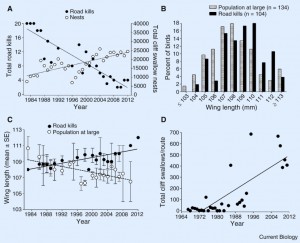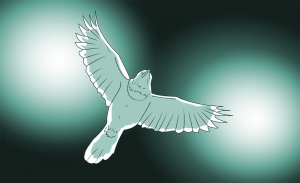I’ve recently been spending a lot of time working with undergraduate students and marking their work and much of it has been on the subject of evolution and natural selection. This can be a difficult topic to clarify in the mind of younger students and it’s often difficult to recall specific examples which can be easily explained. Usually you have to come up with some hypothetical situation whereby some selection pressure drives a population towards evolutionary change. A newly published study in Current Biology by Brown and Brown however provides a beautiful (and more importantly brief) example of evolution and natural selection at work.
They have been studying populations of cliff swallows (Petrochelidon pyrrhonota) in Nebraska for almost thirty years, attempting to evaluate the costs and benefits of group living in these highly social birds. In an interview with John Dankosky lead author Charles brown explains how his habit of checking road killed birds for rings (or bands, as they are called in the US) led to an intriguing discovery. Firstly they noticed that over the years fewer and fewer birds were being killed on the roads (Figure 1), but also that these road killed birds tended to have longer wing lengths compared to individuals of the general population.

So if you are a cliff swallow why does having a longer wing make you more likely to be run over by a car? Well it all comes down to the angle of escape. Birds with shorter more rounded wings are able to take off more vertically compared to individuals with longer more pointed wings, essentially shorter winged birds can get out of the way of oncoming traffic more quickly. It seems that this selection pressure from vehicles has been driving (I make no apology for the pun) the evolution of shorter wings in this population of cliff swallows.
Cliff swallows are migratory birds, travelling from South to North America annually and longer more pointed wings are generally seen as an advantage when it comes to long distance flight. Therefore it seems that the shorter winged individuals may pay an energetic cost compared to their longer winged conspecifics, but this cost may be outweighed by the benefit of being able to avoid traffic. Whatever the case may be I think this study provides a nice example of selection pressures steering morphological adaptations along the road to survival. Next time a student needs clarification on this I’ll remember, tyre pressure.
Author
Keith McMahon: mcmahok[at]tcd.ie
Photo credit
Tommie Kelly (www.tommiekelly.com)




